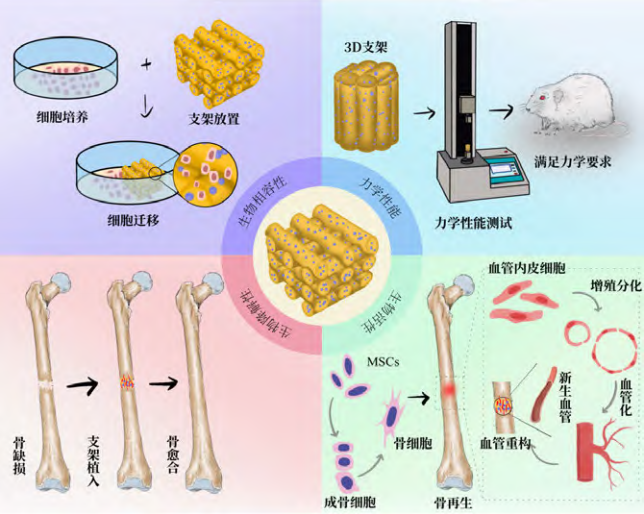3D Printing Biodegradable Materials: A New Pathway for Bone Defect Treatment
Bone defects are a common issue following trauma, infection, or tumor treatment. The bone itself has difficulty repairing larger gaps, and traditional treatments often rely on autologous bone grafting or artificial bone implantation. However, the former is limited by donor shortages, while the latter often requires a second surgery for removal. A research team led by Zhan Longwen from the First Clinical Medical College of Gansu University of Chinese Medicine focuses on using 3D printed biodegradable materials to address this problem, providing a better technical solution for bone defect repair.
The core idea of the research is to utilize the precision of 3D printing technology, combined with the characteristics of biodegradable materials, to create bone repair scaffolds that can simultaneously "support, induce, and degrade." The key advantage of these scaffolds lies in "customization on demand": by modeling based on medical imaging data, they can accurately match the shape and size of the patient's bone defect, even replicating the porous structure of natural bones, thereby solving the problem of poor fit between traditional repair materials and the defect site.
In terms of material selection, the study focused on testing various biodegradable materials and composites, including synthetic polymers such as polylactic acid (PLA) and polycaprolactone (PCL), as well as bioceramics like hydroxyapatite (HA) and beta-tricalcium phosphate (β-TCP). Single materials often have shortcomings, such as PLA having sufficient mechanical strength but degrading slowly, and β-TCP having good degradability but high brittleness. Therefore, composite modification has become a key strategy—combining the toughness of polymer materials with the osteoconductivity of ceramic materials can provide the necessary mechanical support in the early postoperative period while aligning the degradation rate with the pace of new bone growth.

Four Essential Properties of 3D Printed Degradable Scaffolds
The "functional design" of the scaffold is a highlight of the research. The porous structure created by 3D printing not only reduces the weight of the scaffold but also provides channels for cell adhesion, nutrient delivery, and vascular ingrowth, addressing the critical issue of "nutrition not keeping up" in bone repair. More importantly, the scaffold can serve as a "drug carrier," slowly releasing growth factors such as bone morphogenetic proteins (BMPs) during degradation, continuously inducing mesenchymal stem cells to differentiate into osteoblasts and actively promoting new bone formation. Some composite scaffolds also incorporate active ions like zinc and strontium, further enhancing anti-inflammatory effects and bone integration capabilities.
Performance testing and animal experiments validated the effectiveness of the scheme: after the implantation of the stent, the inflammatory response at the site of bone defect in animals was significantly reduced. Within 4 to 8 weeks, new bone tissue was gradually observed to grow into the pores of the stent. After 12 weeks, most of the stent had degraded, and the new bone was able to bear normal physiological loads, without any issues of immune rejection or material residue. Compared to traditional methods, this technology not only shortens the healing period but also avoids the pain of secondary surgery.
In summary, this study confirms that 3D printed biodegradable material scaffolds can achieve the synergistic effects of "personalized adaptation, mechanical support, bone induction regeneration, and synchronous degradation." This not only addresses many limitations of traditional bone defect treatments but also provides a practical technical reference for clinical applications, and is expected to become one of the mainstream directions for future bone defect treatments.
【Copyright and Disclaimer】The above information is collected and organized by PlastMatch. The copyright belongs to the original author. This article is reprinted for the purpose of providing more information, and it does not imply that PlastMatch endorses the views expressed in the article or guarantees its accuracy. If there are any errors in the source attribution or if your legitimate rights have been infringed, please contact us, and we will promptly correct or remove the content. If other media, websites, or individuals use the aforementioned content, they must clearly indicate the original source and origin of the work and assume legal responsibility on their own.
Most Popular
-

Dow, Wanhua, Huntsman Intensively Raise Prices! Who Controls the Global MDI Prices?
-

Clariant Unveils Cost-Cutting Plan Details, Plans to Shut Down Multiple Plants
-

[Today's Plastics Market] General Materials Weakly Fluctuate, Engineering Materials Steadily Rise
-

Daily Review: Polyethylene Prices Under Weak Consolidation, Sellers Face Significant Pressure to Move Inventory
-

EU Plans to Introduce New Rules Banning 100% Procurement of Chinese Products! Asahi Kasei and Teijin Reach Absorption Merger Agreement






